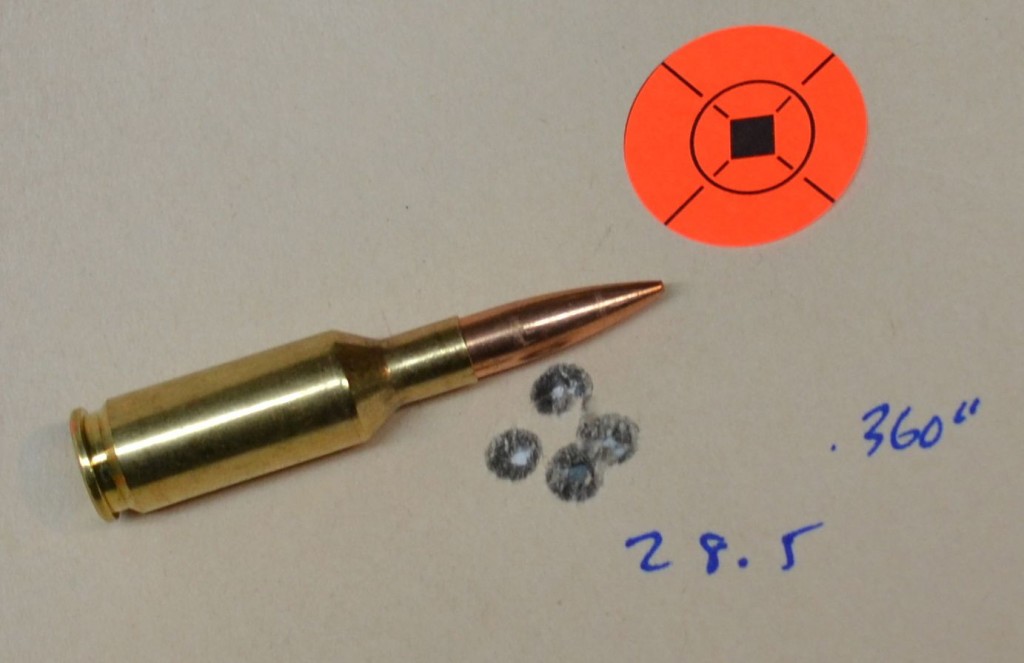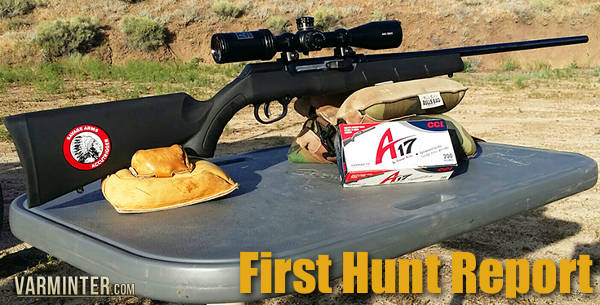|
|
December 3rd, 2015

Want a preview of SHOT Show 2016? Then check out the just-released December 2015 Digital Edition of Shooting Industry Magazine. This free, digital eZine contains a 22-page spread with dozens of new products — rifles, pistols, optics, reloading tools, hunting gear and more. The product showcase article reveals many new-for-2016 firearms. Savage is bringing out a laminated wood-stocked version of its A17 17HMR Rifle, and there are new rifles from FNH, Howa, Merkel, Weatherby and more.
CLICK HERE for PDF Version of December 2015 Shooting Industry Magazine.


Shooting Industry Buyer’s Guide Lists Thousands of Companies
The December Edition of Shooting Industry Magazine also contains a very comprehensive Shooting Industry Buyer’s Guide, starting on page 76. This 80-page resource lists 2500+ companies, complete with address, phone number(s), email, and website link. All the major precision shooting suppliers, such as Berger Bullets, Lapua, Hodgdon, McMillan, Nightforce, Redding, Sierra etc. are listed. In addition, you’ll find an easy-to-search, stream-lined version of the Buyers Guide at SIBuyersGuide.com.

November 16th, 2015

At the request of our readers, we have launched a “Deals of the Week” feature. If this proves popular, we’ll try to run this every Monday. Here are some of the best deals on hardware, reloading components, and shooting accessories. Be aware that sale prices are subject to change, and once clearance inventory is sold, it’s gone for good. You snooze you lose.
1. Leupold — $100 Mail-In Rebate with Any VX-3 Scope

Purchase any Leupold VX-3 riflescope from November 15th, 2015 to December 31st, 2015 and you will receive a rebate in the form of a $100.00 check.
Here’s one of the best rebates we’ve seen all year. Right now you can get $100.00 back on any Leupold VX-3 Riflescope. The rebate applies to the entire VX-3 line. After purchase you can apply for the rebate online or by mailing in the Leupold VX-3 Rebate Form. For more info, visit www.Leupold.com/rewards.
2. Amazon — Stackable, Lockable 85-lb Capacity Ammo Crates

|
This is a great product from MTM. These stackable, lockable “Ammo Crates” hold up to 85 pounds of shooting supplies. Choose from two different versions, the Large (7.25″-deep) Ammo Crate will hold rifle ammo in individual boxes, while the Medium (4.5″-deep) Ammo Crate is ideal for shotgun shells. Buyer love these crates. Read the user reviews on Amazon. Here’s just one recent example: “5 Stars — I have purchased four of these over the last several months. Construction, dimensions, lock ability are all outstanding. The ability to store 500 rounds of 12ga in a single crate is fantastic. When I saw them on sale today…I grabbed another four.” — Go Navy (verified purchaser) |
|
|
3. Cabela’s — Pre-Black Friday Gun Deals

Cabela’s is offering deep discounts on select guns as part of a pre-Black Friday promotion. Among the best deals is a Savage 12 FV rifle with varmint barrel for just $379.99, $40 off. This is available in four chamberings: .204 Ruger, .223 Rem, 22-250, and .308 Win. There are also good deals on handguns, scopes, and shooting accessories.
4. Optics Planet — Leupold Mark AR MOD 1 1.5-4x20mm

Scopes for Service Rifles. Starting next year, under proposed new NRA Competition Rules, Service Rifle shooters will be able to use optical sights with a max magnification of 4.5X (fixed power or variable). At one-third the cost of a 4X ACOG, the Leupold 1.5-4X Mark AR is a good scope choice for the new optics-legal Service Rifle Class. Optics Planet currently has this on Sale for $299.99. With a Duplex reticle, this is also a fine hunting scope.
5. Stocky’s Stocks — Composite Rifle Stock

Here’s a killer deal on a versatile Stocky’s Long Range Stock with aluminum V-block bedding system. For just $199.99, order this for Rem/Rem Clone long actions or short actions, with either narrow or wide (varmint/tactical) barrel channel.
6. Precision Reloading — Forster Die Set (.284 Win or 7mm WSM)

Getting started in F-Open competition? Here’s a good set-up for those who need to load quality 7mm match ammo with low run-out. Right now Precision Reloading is offering a Forster 2-die set with sizing die and Micrometer-top seater for just $78.69. Precision Reloading also has a 7mm WSM die site with Micrometer seater for the same low price. That’s another popular F-Open and hunting cartridge.
7. Grafs.com — SK Standard Plus at $5.99 per Box

This is very good European-made rimfire ammo at an affordable price. SK Standard Plus is much better than most low-priced rimfire ammo. This is a good choice for cross-training, fun plinking, or rimfire tactical matches. When we don’t need ultra-high-quality Eley or Lapua match .22 LR ammo, we’re happy to shoot SK Standard Plus. The Grafs.com price includes shipping (after one flat $7.95 fee).
8. Harbor Freight — Bargain 59″ Safe and Metal Workbench

Harbor Freight has a number of good deals offered through the end of November. Two that caught our eye were “Super Coupon” deals. Get a 59″ Tall Executive Safe for just $298.98 with Super Coupon. Or, if you need a general purpose bench with power outlet, choose this handy Multi-Purpose 2-Drawer Bench for just $84.99 with Coupon. Note, we do NOT recommend this bench for use with reloading presses. However, it is useful for general light duties and storage.
October 4th, 2015

Click for full-screen photo.
Savage has started to ship its new .308 Win Model 11 Scout rifle. Based on the concept popularized by Col. Jeff Cooper, the Savage Scout is designed to be short and handy, with an 18″ barrel and forward-mounted optic. This new Savage was unveiled at SHOT Show in January, 2015, but production models are just now starting to appear at dealers.

The Model 11 Scout comes complete with iron sights (blade front, Williams peep rear). A cantilevered Picatinny rail accepts forward-mounted, long eye-relief scopes. Available in dark Tan or OD Green*, the Model 11 Scout comes with a 10-round detachable magazine (see below). The only chambering currently offered is .308 Winchester. The gun ships with a screw-on muzzle brake. Rifle weight (without optic) is a modest 7.8 pounds.
September 19th, 2015
 Larry Racine is a respected gunsmith based in New Hampshire. He is also a two-time member of the U.S. Palma Team, and a five-time New Hampshire State High Power rifle champion. Larry, who runs LPR Gunsmithing, has developed a brilliantly simple means of switching rifle barrels with an ordinary spanner or open-end wrench. With this set-up you can switch barrels in the field in seconds without the need for a barrel vise. Larry Racine is a respected gunsmith based in New Hampshire. He is also a two-time member of the U.S. Palma Team, and a five-time New Hampshire State High Power rifle champion. Larry, who runs LPR Gunsmithing, has developed a brilliantly simple means of switching rifle barrels with an ordinary spanner or open-end wrench. With this set-up you can switch barrels in the field in seconds without the need for a barrel vise.
For most barrels, Larry mills a hex with six flats on the end of the barrel. This allows a shooter to change barrels quickly at home or on the line with a simple box-head wrench or a socket wrench. Larry says: “You don’t even have to take the barreled action out of the gun. Just set the buttstock on the ground, between your feet, put a wrench on it, hit it with the palm of your hand — and off comes the barrel.” For barrels fitted with a muzzle brake, Larry has a slightly different system. He mills two flats behind the brake so you can use an open-end wrench to do the job.
With either a hex on the end, or two flats for a brake-equipped rifle, the system works with any medium- to heavy-contour barrel with a muzzle-diameter of at least 0.700″. This will even work for high-power rigs using clamp-on sights or bloop tubes. Larry explains: “A lot of us here in New England use clamp-on front sights. The barrel will be turned to 0.750 for the sight, with the hex on the end. A bloop tube can go right over the end, no problem.”
Larry has used this system over the past few years to win a number of matches. In one 600-yard 3 by 20 prone match, Larry used three different barrels, with three different chamberings, on the same Savage rifle. Larry changed the barrels on the line.
Larry was able to do this because the system has little to no loss of zero from one installation of a given barrel to the next installation of that barrel. This lets the shooter start the match with confidence that the first sighter will be on paper. Larry reports that the simple system works great: “To date we have used this system on Savage, Remington, Winchester, RPA, and Nesika actions.”
Racine’s system is very affordable. If Larry does the chamber work on your barrel he charges $45.00 extra to mill a hex or two flats on your barrel. If you only want the hex or flats done, Larry charges $55.00. For more info, visit LPRGunsmith.com or call Larry at (603) 357-0055.
July 9th, 2015

Barrel nut system allows “Pre-Fit” barrel installation on a Remington action. CLICK photo to zoom.
REMAGE Project Report by Bill, Rifleshooter.com Editor
Installing a new barrel on your Remington 700 (especially without a lathe) may seem like a daunting task, but thanks to companies like McGowen Precision Barrels, there are easier alternatives. By adopting a Savage-style barrel nut on a 1 1/16″ thread for a Remington 700 receiver, pre-chambered (aka “pre-fit”) barrels can be easily swapped with just a few hand tools. This system is sometimes called a REMAGE conversion (for “REMington savAGE”).

Using a few tools from Brownells: Remington 700 Action Wrench, Barrel Vise, Go and No-Go Gauges, Recoil Lug Alignment Tool, and a Savage Barrel Nut Wrench, I was able to swap the .308 Winchester barrel off of my Remington 700 short action and install the new McGowen pre-fit, pre-chambered barrel, converting it to a tack-driving 6BR (aka 6mmBR Norma).
The existing barrel is simply removed from the action (normally the hardest part) and the new barrel is screwed on with the Go Gauge in place. The barrel nut is tightened against the action, headspace verified with the Go Gauge, and you are off to the range. It takes all of the machine work out of the barreling process. Note: the barrel nut has a slightly larger diameter and some stocks may require minor inletting. Also if you are shooting fired brass from another rifle with the same chambering, you should FL-size the brass before loading it for your new pre-fit barrel.

My McGowen Remage barrel looks and shoots great. I’ve written two longer articles that provide greater detail about this project. To learn more about how the barrel was installed, read: Rebarrel a Remington 700 without a lathe: McGowen’s Remage barrel conversion. To see how the rifle performed at the range, read: McGowen Remage Barrel Review: Spoiler Alert- It Shoots!.
Bill has been a serious shooter for over 20 years. A former Marine Corps Sergeant, he’s competed and placed in High Power Rifle, ISPC, USPSA, IDPA, 3-Gun, F-Class, and precision rifle disciplines. In addition to being an NRA-certified firearms instructor and range officer, Bill has hunted big game in North America, South America, and Africa. Bill writes extensively about gunsmithing, precision rifles, and the shooting sports on his blog, Rifleshooter.com.
June 27th, 2015

Varminter.com recently released a First Hunt Report on the new Savage A17 rifle. Savage’s new semi-auto .17 HMR has caused quite a stir. Accurate and affordable, the Savage A17 is also the first .17 HMR to feature a delayed blow-back action. We think the A17 may be the most important new rimfire rifle of 2015, so we were pleased to see that Eric Mayer, Editor of Varminter.com, put the new semi-auto Savage through its paces.
Mayer wanted to see how the new Savage would perform, accuracy-wise, and he also wanted to see how the A17 fared in the field. Mayer achieved one-MOA accuracy with the Savage A17 using the latest CCI-brand ammo, and he demonstrated the A17 is wickedly effective on ground squirrels. Here are some highlights from Varminter.com’s Savage A17 First Hunt Report:
June 18th, 2015

We’ve seen a huge surge of interest in extreme long-range shooting in the past year. Guys are testing their shooting skills at one mile (1760 yards) and beyond. However, it’s kind of pointless to toss expensive bullets downrange if you can’t see your hits (and plot the misses). For that reason, a good target cam system is an essential piece of kit for any extreme-range shootist. Here is a report on a system developed by Forum member Mark Dalzell (aka “MDSlammer”) a couple years ago. With elevated directional antennas, this system worked reliably at 2300 yards (1.3 miles).
Mark Dalzell likes to shoot at extreme long range in the Nevada Desert. (See 2300-yard Hits in VIDEO). In order to see both hits and misses at ranges out to 2300 yards, Mark assembled a target-cam system that broadcasts multiple video cam feeds wirelessly to a receiver on the firing line. Down-range, Mark positioned a high-gain antenna. This was key — without the antenna the system’s useful range was less than 1000 yards. But with the hi-gain antenna Mark gets very clear signals from 2300 yards.

May 3rd, 2015

Here’s a report posted by long-range shooter Grizzman on the LiveLeak video hosting site. Grizzman engaged an 18″x24″ steel target at the distance of 2530 yards — 1.43 miles. Grizzman produced a great video that really gives you a sense of the distance (see the zoom footage at the 0:30 time mark). At this distance, the ballistics are remarkable. Grizzman’s .338-cal, 300gr Berger Hybrid bullets went transonic at 2400 yards and dropped 228 feet (69.5 meters) over their 2530-yard trajectory.
WATCH Video — Second camera at target records bullet impacts (see and hear the hits):
You can see more Long-Range Shooting Videos on Grizzman’s Live Leak Channel. Among the interesting videos is a 1K Cinder Block Shoot: .338 LM Shoot Cinder Blocks at 1000 Yards.
March 11th, 2015

They say a picture is worth a thousand words. In this case a video is way more illuminating than anything we can write. The video below, produced by Savage, demonstrates how the new 17 HMR Savage A17 rifle works. The video includes nicely-done 3D Graphics that illustrate the function of the A17’s delayed-blowback action with “interrupter lug”. Using “X-Ray View” animation, the video shows what happens INSIDE the chamber as rounds are fired. The video also explains how the 17 HMR presents a tougher engineering challenge than the lower-pressure .22 LR cartridge.
Watch this Video — You’ll Learn Something about Semi-Auto Rimfires
NOTE to Readers: Watch the video! If you have any interest in how guns work, check this out (full-screen if possible). For some reason (maybe slow connections), most readers skip over the videos we embed in our stories. In this case, take 3 minutes to watch. Click arrows button to view Full-Screen.

Savage officially launched the A17 this month, after previewing the new 17 HMR rifle at SHOT Show in January. We tested the gun on Media Day and came away very impressed. The A17 fed and functioned flawlessly. It is fun to shoot, and it will be affordable. MSRP is $469.00 so street price should be about $425.00. READ AccurateShooter A17 Report.

We plan to test one of these very soon. If the field test goes as well as I expect, your Editor will probably buy one of these rifles. The A17 has a barrel nut system just like centerfire Savage rifles. This means it will be easy to fit an aftermarket custom barrel to the A17. We already have some ideas for a suppressed A17 project gun with upgraded stock and barrel(s). Stay tuned….

The Magic Chicklet
Look below at the A17 bolt. The little black hardened metal piece (called a “chicklet” by the Savage engineers) is the secret ingredient. This “Interrupter Lug” retracts, allowing the A17 to operate in delayed blow-back mode. That permits the A17 to function flawlessly with the 17 HMR cartridge.

January 22nd, 2015
We’ll give you a break from SHOT Show coverage by taking you across the Atlantic to Great Britain. There Chris Parkin has been putting a Savage F-TR Rifle through its paces. Chris has reviewed this popular rifle in a field test just published by Target Shooter Magazine. Chris wrote a very detailed and thorough review. If you are considering any factory-based rifle for F-TR competition you should read this article. It is lengthy, but the text and photos are good and it is worth the investment of time.

CLICK HERE to Read Savage F-TR Rifle Review
CLICK HERE to Download Savage F-TR Review as PDF File

|



























 Larry Racine is a respected gunsmith based in New Hampshire. He is also a two-time member of the U.S. Palma Team, and a five-time New Hampshire State High Power rifle champion. Larry, who runs
Larry Racine is a respected gunsmith based in New Hampshire. He is also a two-time member of the U.S. Palma Team, and a five-time New Hampshire State High Power rifle champion. Larry, who runs 


















